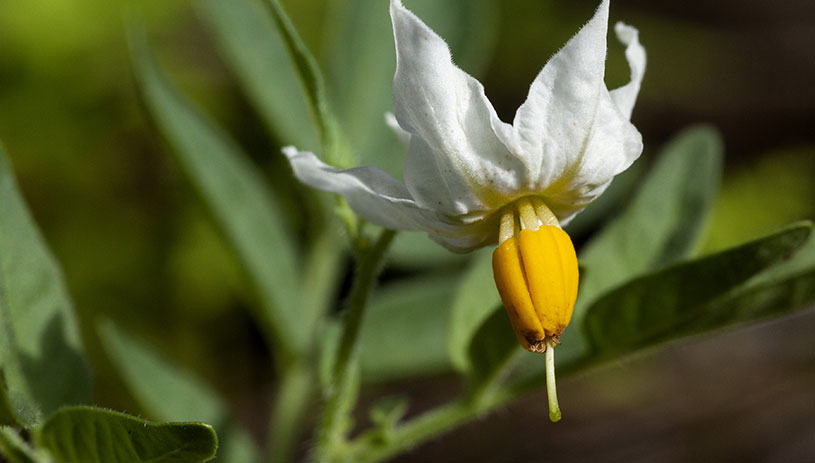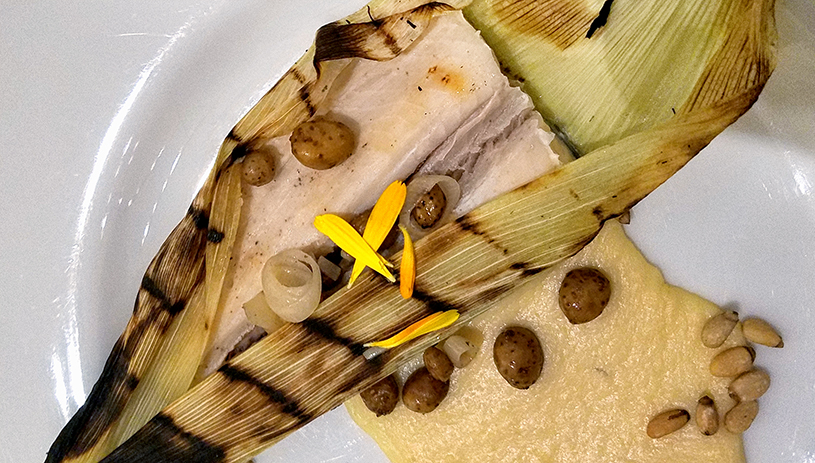
 by Tim Peterson, Cultural Landscapes Director
by Tim Peterson, Cultural Landscapes Director
Western scientists believe that corn, beans, and squash (a symbiotic crop combination known as the “three sisters”) have been cultivated in the American Southwest for at least 4,000 years after being brought north from Mesoamerica. But it turns out an even older sister — the Four Corners potato — was here first.
Thanks to the spotlight on Bears Ears National Monument, Western science is finally catching up to Indigenous traditional knowledge when it comes to the ancient tuber and its cultural history. A new University of Utah study of the potato validates what Indigenous peoples already knew: Bears Ears is connected to a much larger cultural landscape by traditional foodways.
Chronicling the journey of the Four Corners potato (Solanum jamesii), a team of researchers at the University of Utah found that “[w]hile the unique distribution of the Four Corners potato came as a surprise to scientists and researchers, local Tribal members suspected this all along.”
These potatoes have been self-propagating near cultural places in and around the Bears Ears region since being planted there well before Ancestral Puebloans migrated to their current homes in northern Arizona, New Mexico, and western Texas, and potato populations in some places are so vigorous and healthy that the site of the town of Escalante, Utah was once named Potato Valley by European settlers.
Most domestic potatoes eaten today trace their genetic ancestry to potatoes cultivated in the Andes 7,000 to 8,000 years ago, but evidence of Four Corners potato starch on grinding stones and tools found in North Creek Shelter near Escalante, Utah yielded a surprising result for Western scientists. Four Corners potatoes were eaten in southern Utah some 3,000 to 4,000 years before domestication in the Andes — and some as far back as 10,000 to 11,000 years ago.
 A Four Corner potato plant blooming in New Mexico. PATRICK ALEXANDER, WIKIMEDIA
A Four Corner potato plant blooming in New Mexico. PATRICK ALEXANDER, WIKIMEDIA
Hardy and ultra-nutritious, the Four Corners potato has twice the iron, calcium, magnesium, and protein of modern domesticated red potato. A single mother tuber can yield up to 600 small potatoes in a single growing season, and the plants are incredibly drought tolerant. Heavily dependent on summer monsoon rains for flowering and fruiting, the tubers can survive over multiple drought years and remain dormant for up to 14 years.
Tracing genetic markers, the new research documents the centuries-long journey of the humble spud, showing that the Four Corners potato has been gathered, traded, and cultivated throughout the region, connecting ancient foodways from Grand Staircase-Escalante National Monument to Bears Ears to New Mexico, southern Arizona, and western Texas.
Analyzing potato genetics from 25 sites, researchers found that “[p]opulations in Escalante, Utah were related to those on the Mogollon Rim (400 km south) and had multiple origins and significant disjunctions with those populations in Bears Ears, Chaco Canyon, and Mesa Verde sites.”
“The potato joins a large assemblage of goods that were traded across this vast cultural landscape. For millennia, people of the southwest participated in social networks, migration and trade routes in the region.” — Lisbeth Louderback, study co-author and associate professor of anthropology at the University of Utah
Future genetic research on the potato could include investigating whether the potatoes were selectively bred for frost tolerance, size, yield, or flavor.
Beyond expanding Western science’s understanding of Bears Ears’ history, reinvigorating the traditional foods movement is another unexpected and inspiring outcome of protecting and preserving the Bears Ears cultural landscape. University of Utah scientists are now working to share tubers with 30 Indigenous farmers, mostly Hopi and Diné.
 Alastair Lee Bitsóí, Diné, holds a harvest of Four Corners Potatoes in his hands (left) and in a Diné Basket (right). ALISTAIR BITSÓÍ
Alastair Lee Bitsóí, Diné, holds a harvest of Four Corners Potatoes in his hands (left) and in a Diné Basket (right). ALISTAIR BITSÓÍ
One of those farmers is Alastair Lee Bitsóí (Diné), a journalist who grows the Four Corners potato near Nahashchʼidí in the shadow of the Chʼóshgai Mountains.
“Tribes of the Four Corners region have nurtured a connection to food and landscape biodiversity since time immemorial. I’ve grown spuds from Bears Ears, Grand Staircase and Mesa Verde region at my family’s farm in the Navajo Nation, and from them a new generation has been born. Like the ancestors, I am a dispersal agent for its transport and cultivation,” said Bitsóí.
The Four Corners potato can be made sweeter by cooking it with bentonite clay — a traditional practice Cynthia Wilson (Diné), calls glēsh or “potato clay” — to overcome the tuber’s naturally bitter taste.
“Repatriating the potato is a way to capture our relationship with food and the spiritual elements of how food is grown, gathered, hunted and shared through our communities. They can pass on the knowledge to the younger generation and help us get back to harvesting and collecting and hunting," said Cynthia Wilson, former Utah Diné Bikéyah traditional foods director.
 Four Corners potatoes prepared at the Utah Diné Bikéyah’s traditional foods dinner in 2018. TIM PETERSON
Four Corners potatoes prepared at the Utah Diné Bikéyah’s traditional foods dinner in 2018. TIM PETERSON
I was lucky enough to sample the thumbnail-sized potatoes at Utah Diné Bikéyah’s traditional foods dinner in 2018. I can report that they’re earthy and delicious with a pinyon nut puree. When I was told we’d be dining on ancient potatoes, I asked, “do you have any fresh ones?” Turns out I needn’t have worried about them being stale: they were grown that year.
Utah voters strongly support national monuments in general, and Bears Ears and Grand Staircase-Escalante in particular, a new poll shows.
Read MoreA small victory in the legal case challenging Daneros uranium mine, near Bears Ears National Monument.
Read MoreBears Ears petroglyph panels and cultural sites protected by new proposed management plan.
Read More